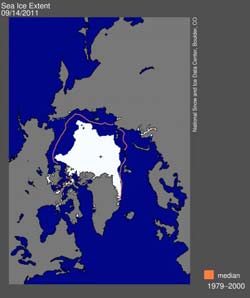Arctic sea ice reaches minimum 2011 extent, making it second lowest in satellite record

This chart shows the 2011 September minimum of Arctic sea ice extent compared with the median 1979-2000 September minimum measurements. Credit: NSIDC<br>
The Arctic sea ice extent fell to 1.67 million square miles, or 4.33 million square kilometers on Sept. 9, 2011. This year's minimum of 1.67 million square miles is more than 1 million square miles below the 1979-2000 monthly average extent for September — an area larger than Texas and California combined.
While this year's September minimum extent was greater than the all-time low in 2007, it remains significantly below the long-term average and well outside the range of natural climate variability, according to scientists involved in the analysis. Most scientists believe the shrinking Arctic sea ice is tied to warming temperatures caused by an increase in human-produced greenhouse gases pumped into Earth's atmosphere.
“Every summer that we see a very low ice extent in September sets us up for a similar situation the following year,” said NSIDC Director Mark Serreze, also a professor in CU-Boulder's geography department. “The Arctic sea ice cover is so thin now compared to 30 years ago that it just can't take a hit anymore. This overall pattern of thinning ice in the Arctic in recent decades is really starting to catch up with us.”
Serreze said that in 2007, the year of record low Arctic sea ice, there was a “nearly perfect” set-up of specific weather conditions. Winds pushed in more warm air over the Arctic than usual, helping to melt sea ice, and winds also pushed the floating ice chunks together into a smaller area. “It is interesting that this year, the second lowest sea ice extent ever recorded, that we didn't see that kind of weather pattern at all,” he said.
The last five years have been the five lowest Arctic sea ice extents recorded since satellite measurements began in 1979, said CU-Boulder's Walt Meier, an NSIDC scientist. “The primary driver of these low sea ice conditions is rising temperatures in the Arctic, and we definitely are heading in the direction of ice-free summers,” he said. “Our best estimates now indicate that may occur by about 2030 or 2040.”
There still is a chance the sea ice extent could fall slightly due to changing winds or late season melt, said Meier. During the first week of October, CU-Boulder's NSIDC will issue a full analysis of the 2011 results and a comparison to previous years.
NSIDC is part of CU-Boulder's Cooperative Institute for Research in Environmental Sciences — a joint institute of CU-Boulder and the National Oceanic and Atmospheric Administration headquartered on the CU campus — and is funded primarily by NASA.
NSIDC's sea ice data come from the Special Sensor Microwave Imager/Sounder sensor on the Defense Meteorological Satellite Program F17 satellite using methods developed at NASA's Goddard Space Flight Center in Greenbelt, Md.
For more information and graphics visit CU-Boulder's NSIDC website at http://nsidc.org/arcticseaicenews/2011/091511.html.
Contact:
Walt Meier, 303-492-6508
Walt@nsidc.org
Mark Serreze, 303-492-2963
serreze@kryos.colorado.edu
Katherine Leitzell, 303-492-1497
leitzell@nsidc.org
Jim Scott. CU media relations, 303-492-3114
Jim.Scott@colorado.edu
Media Contact
All latest news from the category: Earth Sciences
Earth Sciences (also referred to as Geosciences), which deals with basic issues surrounding our planet, plays a vital role in the area of energy and raw materials supply.
Earth Sciences comprises subjects such as geology, geography, geological informatics, paleontology, mineralogy, petrography, crystallography, geophysics, geodesy, glaciology, cartography, photogrammetry, meteorology and seismology, early-warning systems, earthquake research and polar research.
Newest articles

Bringing bio-inspired robots to life
Nebraska researcher Eric Markvicka gets NSF CAREER Award to pursue manufacture of novel materials for soft robotics and stretchable electronics. Engineers are increasingly eager to develop robots that mimic the…

Bella moths use poison to attract mates
Scientists are closer to finding out how. Pyrrolizidine alkaloids are as bitter and toxic as they are hard to pronounce. They’re produced by several different types of plants and are…

AI tool creates ‘synthetic’ images of cells
…for enhanced microscopy analysis. Observing individual cells through microscopes can reveal a range of important cell biological phenomena that frequently play a role in human diseases, but the process of…





















